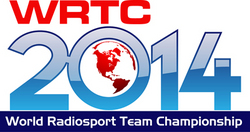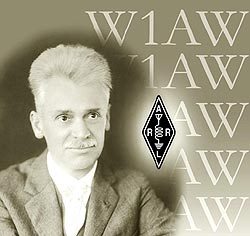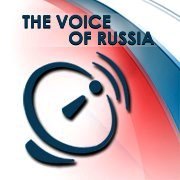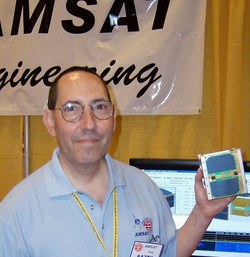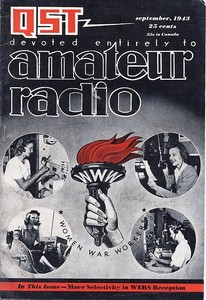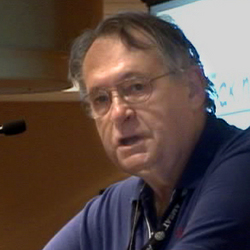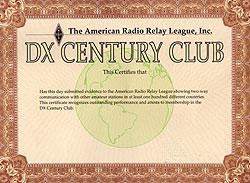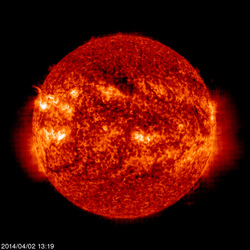 April 3, 2014 John E. Ross, KD8IDJ, Editor
| |||||||||||||||||||
ARRL Calls for Timely, Visible FCC Amateur Radio Enforcement In comments filed in response to the FCC's February 14 Report on Process Reform (GN Docket 14-25), the ARRL has called for a more visible, responsive Amateur Radio enforcement program. The League also said it was concerned that FCC policies for adjudicating certain complaints of interference to radio amateurs, especially those involving electric utilities, provide no incentive for the utilities to resolve them. The ARRL was further critical of the fact that FCC petitions for rule making and spectrum allocation proceedings often take years to resolve. But the League confined the bulk of its comments to perceived shortcomings in the Amateur Radio enforcement program.
"[T]he visibility of the Commission's enforcement program for the Amateur Service is wholly inadequate, resulting in a widespread, albeit inaccurate, public perception that there is no active enforcement in our service," the League's comments asserted. The ARRL said "deterrence based on visibility is a critical component of a successful compliance campaign." The most successful -- and visible -- period of Amateur Radio enforcement in recent years was between 1997 and 2008, the ARRL said. According to the League, compliance during that period was a result of "the visibility in the Amateur Radio community of a single member of the Commission's Enforcement Bureau staff at Amateur Radio events" and of keeping the Amateur Radio media fully informed on what was being done to resolve a particular enforcement issue. FCC-imposed constraints in the past few years have had "a devastating effect on the entire philosophy of the program and its success," the League told the Commission. Among other factors, the ARRL pointed to the "extensive approvals" required before the release of enforcement correspondence. Enforcement actions that are taken, the League continued, are not released to the Amateur Radio media. "This deprives radio amateurs of the knowledge that the Commission is indeed investigating and responding to a given enforcement problem," the ARRL said. "The result is the perception that nothing is being done in a given case, and frustration builds rapidly among the radio amateurs who have to endure the rule violator on an ongoing basis." "[L]imitations imposed on the visibility of enforcement actions in recent years have significantly reduced the effectiveness of the program," the ARRL stressed, and "directly resulted in notable and unacceptable increases in rule violations, most especially malicious interference." Further, the ARRL said, Enforcement Bureau personnel responsible for Amateur Radio enforcement should be empowered with greater autonomy to address problems as they arise. The League faulted the FCC's websites -- old and new -- for being "woefully out of date" and not well maintained or presented. "The fact that there are two separate listings of Amateur Radio enforcement actions on two separate FCC websites is, frankly, ridiculous in any case," the ARRL concluded. The ARRL also urged the FCC to make better use of the Amateur Auxiliary -- the ARRL Official Observer Program -- in resolving enforcement complaints. "It is unclear why none of the evidence gathered by OOs is usable other than as a predictor for Commission District Office staff to use in investigating the matter themselves -- if and when their time permits," the League said. "The program is authorized by legislation. It would increase the Commission's efficiency if the work of these volunteers were put to a better use." The ARRL pointed to cases where chronic rule violators who were the subject of hundreds of hours of OO surveillance and off-the-air recordings have "been allowed to continue those activities for periods of years without more than a warning letter." The League said the Report "makes good recommendations" in addressing years-long delays in resolving rule making petitions and open-docket proceedings. As an example it cited the League's 2012 Petition for Rulemaking seeking a new Amateur Radio allocation at 472-479 kHz. "To date, a year and a half after it was filed, this Petition for Rule Making has not been afforded a file number, nor has public comment been solicited on it," the ARRL said. In a Public Notice the FCC said its Report "seeks to further the goal of having the agency operate in the most effective, efficient and transparent way possible." The League said it was not being critical of any individual FCC staffers or managers. "Rather, the remarks are directed at the Commission's policies and processes" and address issues that "result, in large part, from the unenviable necessity of allocating scarce (and in some cases inadequate) human resources available to the Commission." Public Service: Washington Governor Visits Snohomish County EOC Radio Room Snohomish County Auxiliary Communications Service (Snohomish ACS -- formerly RACES) Radio Officer Scott Honaker, N7SS, reported that Washington Gov Jay Inslee toured the Snohomish County Department of Emergency Management EOC in Everett on March 26. The EOC has been central to the ongoing relief effort following the March 22 mudslide near Oso, Washington.
"We saw Gov Inslee walk into the EOC, and a few minutes later the EOC manager brought him into the radio room with a small group," Honaker told ARRL. "The governor shook hands and thanked us and kept asking good questions about issues he'd heard in the field. He was clearly quite engaged." Honaker said the EOC radio room has six radio stations in cubicles, four of them currently monitoring incident traffic. He said ARES DEC George Boswell, K7YHB, has been at the EOC 12 hours a day since last weekend. The March 22 landslide, approximately 3 miles east of Oso -- between Darrington and Arlington -- destroyed some 50 homes or other structures and resulted in 30 deaths, as of April 3. Another 16 people remain missing. The slide blocked the north fork of the Stillaguamish River and covered about 1 mile of State Route 530, cutting off access to Darrington and disrupting telecommunication services.
Snohomish ACS has been handling communication from the EOC and has moved one command vehicle (COM1) to Darrington, where it had been staffed until March 27. A second vehicle was moved to the incident command post in Arlington and is being staffed by dispatchers from 911 call centers. "Our DEM Director has requested we staff COM1 in Darrington again, and [we] will do so until relieved," Honaker said on April 1. Amateur Radio volunteers now are running two 9 hour shifts in the EOC and one 12 hour shift in Darrington." Other Amateur Radio volunteers are providing communication support for the Incident Management Team in Arlington. In addition to Honaker and Boswell, other Amateur Radio volunteers who met with the governor included former ACS Radio Officer Tim Lawson, K7TKA; Erik Robbins, K7QOG; Ann Wright, AA7AG, and Rob Myers, K7RHM. During a radio interview with Brandi Kruse on KIRO in Seattle, Gov Inslee recounted his EOC visit and specifically his visit to the radio room. "It's interesting that they had a volunteer group that really has handled a lot of the communications," the governor said. "They have staffed the communications center so that you could have communications from Darrington across over to the Operations Center in Arlington, because the phones were down for two and a half days." Public Service: Hams on Alert in Wake of Chile Earthquake A magnitude 8.2 earthquake occurred off Northern Chile on April 1, and a powerful 7.6 magnitude aftershock rocked the area on April 3. After the initial temblor, the Radio Club de Chile activated in collaboration with ONEMI, the National Emergency Office of the Ministry of Interior and Public Security.
Radio amateurs established an emergency communication net using 7.050 and 14.255 MHz, according to Julio Zavala, CE3OP. The initial earthquake killed six people and triggered a tsunami that pounded Chile's shore with 7 foot waves. Right after the first quake, Amateur Radio volunteers in Hawaii opened a tsunami radio watch net on the linked statewide State Civil Defense RACES/Oahu Department of Emergency Management VHF/UHF repeaters. The net carried periodic announcements from the Pacific Tsunami Warning Center in Ewa Beach, said ARRL Emergency Coordinator and RACES Coordinator Ron Hashiro, AH6RH. The ETA of the tsunami was 3:24 AM, local time. Amateur Radio observers reported only modest effects, however, and the radio watch net shut down at 4:32 AM, local time. The tsunami advisory was cancelled about 3 hours later. Thousands of people who had evacuated Chile's low-lying coastal areas returned the morning of April 2, after authorities called off the first tsunami alarm. They retreated again after the second earthquake, but a precautionary tsunami alert along the coast and in neighboring Chile was canceled. The threat may not be over, according to Paul Earle, a seismologist at the US Geological Survey National Earthquake Information Center. He said the Tuesday earthquake was insufficient to release the stress in the vicinity of the undersea seismic gap. "It's going to take some time to evaluate the effect of this earthquake on that region," he said. "But people should stay prepared."-- Thanks to Ron Hashiro, AH6RH, Jim Linton, VK3PC, The Daily DX, and Reuters DX: Stormy Weather May Force Retreat of Mellish Reef VK9MT DXpedition Team Deteriorating weather and high winds could force the Mellish Reef VK9MT DXpedition team from the Pacific Atoll to the Evohe, the ship that transported them from Australia a week earlier. The operation may have to be abandoned altogether, if the poor weather persists. The DXpedition began operations on March 29 and had planned to remain on Mellish Reef until April 9.
"The weather continues to change," a team update reported April 3. "Last night there were torrential downpours and high winds." The DXpedition said that antennas survived with no damage, but the operators have removed nonessential equipment and several antennas, including the just-erected 160 meter antenna. While water flowed into the "break tent" through an open window, the operating tents were dry, and no equipment was damaged. "Tomorrow morning we will remove all remaining equipment from the island and head towards Australia," the team said, adding that its immediate destination would depend upon the winds and sea conditions, although the ship eventually would return to its home port of Mackay, Australia. "Even if the storm subsides, it is unlikely we will have enough time to return to the island." Early on April 3, the team reported it was keeping an eye on a tropical depression north of Mellish Reef and made contingency plans to shut down and abandon the reef, at least temporarily. "The safety of the DXpedition team and the crew is the first priority," the team said. The operators were requesting that only those needing Mellish Reef for an all-time new one call the DXpedition. To that end VK9MT intended to focus its attention on bands that drive the highest rates. As of 2000 UTC, VK9MT continued to hold forth on 15, 17, 20, 30, 80, and 75 meters. Last activated in 2009, Mellish Reef is number 22 on ClubLog's most recent mixed-mode DXCC Most Wanted List. -- Thanks to The Daily DX, DX Summit Radiosport: WRTC-2014 Receives ARRL Colvin Grant Award
World Radiosport Team Championship 2014 (WRTC-2014) has announced that it is the recipient of what it called "a significant financial contribution" in the form of an ARRL Colvin Award grant. WRTC-2014 will take place July 8-14 in New England. The Colvin Award is funded by an endowment established by the late Lloyd D. Colvin, W6KG, and administered by the ARRL. Colvin Award grants are conferred in support of Amateur Radio projects that promote international goodwill in the field of DX. "We are honored to receive this prestigious award," said WRTC-2014 Chair Doug Grant, K1DG. "More than just a radio competition, the WRTC is a place where competitors from around the world can create or renew lasting friendships."
In the July event 59 teams of top Amateur Radio contest operators from more than 40 countries will compete from equivalent stations for top honors in the event, which typically takes place every 4 years. Eligibility to participate in WRTC-2014 was based on qualifying scores posted in major contests between 2010 and 2014. A contingent of referees and judges, all well-known contesters in their own right, will oversee the competition and confirm the results. Recent Colvin Award grant recipients include the 2013 K9W Wake Atoll and T33A Banaba Island DXpeditions and the 2014 FT5ZM Amsterdam Island operation. Centennial: W1AW Centennial Operations in Pennsylvania, Oregon, until April 9 (UTC) The ARRL Centennial "W1AW WAS" operations taking place throughout 2014 from each of the 50 states are now in Pennsylvania (W1AW/3) and Oregon (W1AW/7). They will relocate at 0000 UTC on Wednesday, April 9 (the evening of April 8 in US time zones), to Massachusetts (W1AW/1) and Virginia (W1AW/4). During 2014 W1AW will be on the air from every state (at least twice) and most US territories, and it will be easy to work all states solely by contacting W1AW portable operations.
In conjunction with the 100th anniversary of the ARRL, the ARRL Centennial QSO Party kicked off January 1 for a year-long operating event in which participants can accumulate points and win awards. The event is open to all, although only ARRL members and appointees, elected officials, HQ staff and W1AW are worth ARRL Centennial QSO Party points. Working W1AW/x from each state is worth 5 points per contact. To earn the "Worked all States with W1AW Award," work W1AW operating portable from all 50 states. (Working W1AW or W100AW in Connecticut does not count for Connecticut, however. For award credit, participants must work W1AW/1 in Connecticut.) A W1AW WAS certificate and plaque will be available (pricing not yet available). The ARRL has posted an ARRL Centennial QSO Party leader board that participants can use to determine how many points they have accumulated in the Centennial QSO Party and in the W1AW WAS operations. Log in using your Logbook of The World (LoTW) user name and password, and your position will appear at the top of the leader boards. Results are updated daily, based on contacts entered into LoTW. So far this year the W1AW Centennial operations have posted nearly 685,000 contacts, with uploads awaited from some operations. Ham Radio in Space: Lithuania's President Relays Greetings via Amateur Radio CubeSat A greeting from Lithuanian President Dalia Grybauskaite was transmitted via LituanicaSAT-1. Grybauskaite may be the first head of state to send a message via an Amateur Radio satellite, her country's first.
Using a handheld radio and the call sign LY5N, she transmitted through the satellite's FM voice transponder. Her words, "Greetings to all Lithuanians around the world!" were recorded on a memory chip in the satellite and the message was successfully transmitted from space on March 22. Last year Grybauskaite visited the Science Communication and Information Center at Vilnius University and got to see the LituanicaSAT-1 CubeSat, then being readied for its trip into space. LituanicaSAT-1 was launched to the International Space Station on January 9 and deployed into orbit with other Amateur Radio satellites on February 28. The tiny satellite, measuring just 10 x 10 x 10 cm and weighing slightly more than 1 kg, carries a VGA camera and a 145/435 MHz FM Amateur Radio voice transponder, designed and built by Lithuanian radio amateurs. -- Thanks to AMSAT News Service, AMSAT-UK Events: ARRL to Be Represented at National Association of Broadcasters Convention The ARRL will be on hand April 5-10 as more than 100,000 visitors descend on Las Vegas to attend the annual National Association of Broadcasters (NAB) Convention. Hundreds of Amateur Radio operators are expected to be among the attendees at the Las Vegas Convention Center. ARRL Pacific Division Director Bob Vallio, W6RGG, will join local ham radio volunteers in staffing the ARRL booth. Jim Bilan, W7UXB, is coordinating the staff. NAB Science and Technology Vice President John Marino, KR1O, arranged for the generous donation of booth space from the NAB.
Marino and NAB Technology will join Bob Heil, K9EID, of Heil Sound, Broadcast Supply World, Turner Engineering, and DX Engineering in hosting the popular Amateur Radio Operators Reception at the NAB. More than 600 hams from around the world are expected to attend the April 9 event. All Amateur Radio operators are invited, and there is no charge. Nearly 1700 exhibitors will be at the show. The ARRL booth will offer convention attendees information on how to get involved in ham radio, how to become an ARRL member, and how to take advantage of League services. Staffing the ARRL booth are members of the Frontier Amateur Radio Society, the Nellis Radio Amateur Club, the Las Vegas Repeater Association, Nevada Amateur Radio Repeaters Inc, and the Las Vegas Radio Amateur Club. Members of several of the non ARRL-affiliated clubs also assist. -- Thanks to Pacific Division Assistant Director/Nevada Section PIO John Bigley, N7UR Milestones: Voice of Russia Goes Dark After All The Voice of Russia -- the former "Radio Moscow" -- ended its shortwave broadcasts on Tuesday, April 1 -- No fooling! After contradictory announcements and reports last December, it appears the international broadcaster has indeed pulled the plug on its HF transmissions. SWL Tom Witherspoon, K4SWL, contacted VOR. As he reported on his blog, Voice of Russia's Elena Osipova told him, "This is to thank you for your message and confirm the information about the upcoming cancellation of the Voice of Russia's short- and medium wave transmissions as of April 1, 2014."
Richard Weil, KW0U, in St Paul, Minnesota, was able to hear the final shortwave broadcast. "Just barely picked up the last-day broadcast of VOR on 13.805 at 1300 UTC," he commented on Witherspoon's site. He used a dipole in his attic. "No mention on air of a final broadcast, which some services have given before closing down," he added. "Too bad to lose it, but time does move on." Effective December 9, as a result of a decree signed by Russian President Vladimir Putin, the Voice of Russia radio company officially ceased to exist and merged with several other state-run news agencies as part of Rossia Segodnya, a Russia-based international news service. From the 1950s through the 1980s, the station, then as Radio Moscow, was an easy catch for budding short-wave listeners (SWLs), many of whom later gravitated to Amateur Radio. "I remember when the Voice of Russia and Radio Moscow absolutely dominated the shortwaves, especially in my early years as a radio listener," Witherspoon remarked on his blog. "Times have changed for this broadcaster, who has been the mouthpiece for Russia and the Soviet Union." In 2003 VOR was among the first major international radio broadcasters to launch daily broadcasts to Europe in Digital Radio Mondiale (DRM). Milestones: AMSAT-NA Board Member, Officer Tony Monteiro, AA2TX, SK AMSAT Board Member and Vice President-Engineering Anthony J. "Tony" Monteiro, AA2TX, of North Andover, Massachusetts, died March 26. He was 55 and had been suffering from cancer. A "farewell" message was relayed via the FUNcube-1 satellite. First licensed in 1973, Monteiro once described making his first ham radio contact with a transmitter he'd made using parts from an old TV set.
"A Heathkit HR-10B receiver and a 65-foot piece of wire strung out of a window for an antenna made up the rest of my station, which was pretty modest even by 1973 standards," he said. "Even so, I will never forget the thrill of my very first contact." After receiving a BS in electrical engineering and a MS in computer science, Monteiro worked at Bell Laboratories, several startups, and with Cisco Systems, where he managed the development of ADSL, voice over packet, and content networking products. He retired from industry in 2002 to focus on satellite projects. Monteiro joined AMSAT in 1994. He was a frequent presence at AMSAT events, and he played a significant role in space-based hardware development, including the Fox-1 and Fox-2 satellites. The family has requested memorial donations to AMSAT, 850 Sligo Ave, Suite 600, Silver Spring, MD 20910. Read more. -- AMSAT News Service ARRL Centennial Station Giveaway! The ARRL has announced a "Centennial Station Giveaway" as part of its National Centennial Convention in Hartford, Connecticut, July 17-19, 2014. Sponsored by the ARRL and R&L Electronics, the first-prize winner will receive a Grand Prize voucher worth up to $5000 of equipment -- radio, antenna, and accessories -- redeemable for products sold by R&L Electronics. A second-prize winner will receive a $2500 prize voucher for products sold by FlexRadio Systems, also co-sponsored by ARRL.
All paid convention registrants will be entered in the prize drawings (door prizes). Winners will be drawn from among eligible registrants at the end of the convention on Saturday, July 19, 2014. The winner does not need to be present during the drawings. Three-day convention tickets are $75 and include an all-day training workshop and lunch on Thursday. Two-day tickets are $25 ($30 at the door), good for admission on Friday and Saturday. Everyone who attends the convention must register. Feature: A Century of Amateur Radio and the ARRL When the US entered World War II, Amateur Radio operations were immediately shut down for the duration. After one false start, authorization soon was given for amateurs to operate on 112 MHz for emergency drills and actual emergency operations, as members of the War Emergency Radio Service (WERS). During the war years QST published many articles on WERS equipment suitable for 112 MHz -- especially portable and hand-held gear -- and on club preparedness. Announcements in QST made repeated calls for trained operators to volunteer for the military and for civil service. At one time, the Navy made a call for 5000 men specifically to be trained as radar operators and maintenance personnel -- state-of-the-art work.
As America's young men went to various parts of the world to fight the war, the nation called on its women to help with the war effort. Many female hams became military radio operators within the US, and others went to work in defense plants building radio equipment, just as their sisters built the aircraft, ships, and vehicles required by modern warfare. Manufacturers' ads in QST started using photos of radio operation during military training maneuvers and even from the battlefield. Early in the war years, manufacturers were unable to keep up with the military's demand, and other ads called for hams to sell or donate their radio gear and components (panel meters were especially needed) for the war effort. Manufacturers expanded their facilities and work forces as quickly as possible, and they soon were able to meet the need. It has been reported -- but never confirmed -- that, following the attack at Pearl Harbor, Japanese Admiral Isoroku Yamamoto said, "I fear all we have done is to awaken a sleeping giant and fill him with a terrible resolve." Regardless of the proof of that exact quote, Admiral Yamamoto's writings confirmed that those were, indeed, his feelings. And those feelings were soon proven to be correct. Next week: We will continue to look at how hams and the ARRL backed the war effort. In Brief...
FCC Fines CBer $18,000 for Inspection, Quiet Hours Violations: In a Forfeiture Order released March 12, the FCC fined CB operator Nathaniel Johnson, of Pittsburgh, Pennsylvania, $18,000 for "willful and repeated failure" to permit FCC personnel to inspect his station and to comply with "quiet hours" the Commission imposed. The 2012 enforcement action stemmed from neighbors' complaints of interference to telephones and televisions. Because it was unable to inspect Johnson's station, the FCC prohibited him and family members from transmitting between 8 AM and 11:30 PM, but the complaints continued. The Commission issued a Notice of Apparent Liability for Forfeiture and Order (NAL) in the case in May 2013. Dayton Top Band Dinner Speaker Announced: Craig Thompson, K9CT, will present "The FT5ZM TopBand Experience" at the 2014 Dayton Top Band Dinner, Friday, May 16, at the Crowne Plaza Hotel in Downtown Dayton. The event starts with a social hour at 6:15 PM, with dinner at 7:15 PM.
AMSAT/TAPR Banquet Speaker Announced: Tom Clark, K3IO, will be the featured speaker for the eighth annual AMSAT/TAPR Banquet, Friday, May 16, at the Kohler Presidential Banquet Center, 4572 Presidential Way, Kettering, Ohio -- just south of Dayton. Tickets are $30 and must be purchased online by May 13 on the AMSAT website (click on the "AMSAT Store" tab).
Operations Approved for DXCC Credit: The ARRL DXCC Desk has approved the February 26 through March 6, 2014 operation of 3C0BYP -- Annobon -- and the 2013 operation of 9X0HP -- Rwanda -- for DX Century Club credit. If a request for DXCC credit for this operation has been rejected in a prior application, contact ARRL Awards Branch Manager Bill Moore, NC1L, to be placed on the list for an update to your record. Please note the submission date and/or reference number of your application in order to expedite the search for any rejected contacts. DXCC is Amateur Radio's premier award that hams can earn by confirming on-the-air contacts with 100 DXCC "entities," most of which are countries in the traditional sense. You can begin with the basic DXCC award and work your way up to the DXCC Honor Roll. Learn more. -- ARRL Awards Branch Manager Bill Moore, NC1L New World 24 GHz EME Record Claimed: A new world record for moonbounce on 24 GHz -- 17,405.6 kilometers (10,815.3 miles) -- was set March 5 by Rex Moncur, VK7MO, and Charlie Suckling, G3WDG. VK7MO set up on Mount Wellington, near Hobart, the capital of Tasmania, to minimize water vapor attenuation of the 24 GHz signal and to take advantage of the Moon's being close to Earth. The Moon had to be at low elevation, which meant a longer path for the signal through Earth's atmosphere. -- Jim Linton, VK3PC, via Southgate Amateur Radio News The K7RA Solar Update Tad Cook, K7RA, reports from Seattle: Average daily sunspot numbers over the past reporting week (March 27 to April 2) declined from 135.6 to 130.4, compared to the previous 7 days. Average daily solar flux drifted lower too, from 153.2 to 149. The current prediction has solar flux at 155 on April 3, 160 on April 4-7, 155 and 150 on April 8-9, 140 on April 10-11, 135 on April 12-13, then 140 and 145 on April 14-15, 150 on April 16-18, 155 on April 19-22, 145 on April 23-28, and 140 on April 29 through May 2. Predicted planetary A index is 5, 8, 15, 12 and 8 on April 3-7, 5 on April 8-16, 8 on April 17-19, 5 on April 20-22, 8 on April 23-26, 5 on April 27 through May 2, then 8 on May 3-4, 5 on May 5, and 8 on May 6.
On Saturday, March 29, Spaceweather.com reported: "Sunspot AR2017 in the Sun's northern hemisphere is crackling with M-class solar flares, and it has a delta-class magnetic field that harbors energy for even stronger eruptions. Earth-directed flares are possible this weekend." Spaceweather.com subsequently reported: "AR2017 has just unleashed an X1-class solar flare. NASA's Solar Dynamics Observatory captured the extreme ultraviolet flash on March 29 at 1752 UTC." The Australian government's IPS Radio and Space Services issued a geomagnetic disturbance warning at 0445 UTC on April 3. "Active region 12027 produced a M6.5 X-ray flare with associated CME on 02 April. Possible Active to Minor Storm conditions at higher latitudes on 05 April due to CME arrival. INCREASED GEOMAGNETIC ACTIVITY EXPECTED, DUE TO CORONAL MASS EJECTION FOR 05 APRIL 2014." This weekly "Solar Update" in The ARRL Letter is a preview of the "Propagation Bulletin" issued each Friday. The latest bulletin and an archive of past propagation bulletins is on the ARRL website. In tomorrow's bulletin look for an updated forecast, reports from readers including a 6 meter long-path contact, updated and expanded reports of solar flares, and an update to our 3 month moving average of sunspot numbers. Send me your reports and observations. Just Ahead in Radiosport
Visit the Contest Calendar for details. Upcoming ARRL Section, State and Division Conventions and Events
Find conventions and hamfests in your area.
ARRL -- Your One-Stop Resource for Amateur Radio News and Information Join or Renew Today! ARRL membership includes QST, Amateur Radio's most popular and informative journal, delivered to your mailbox each month. Listen to ARRL Audio News, available every Friday. Subscribe to... NCJ -- National Contest Journal. Published bi-monthly, features articles by top contesters, letters, hints, statistics, scores, NA Sprint and QSO Parties. QEX -- A Forum for Communications Experimenters. Published bi-monthly, features technical articles, construction projects, columns and other items of interest to radio amateurs and communications professionals. Free of charge to ARRL members: Subscribe to the ARES E-Letter (monthly public service and emergency communications news), the ARRL Contest Update (bi-weekly contest newsletter), Division and Section news alerts -- and much more! | |||||||||||||||||||
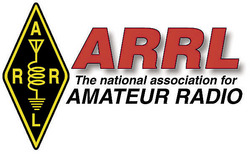
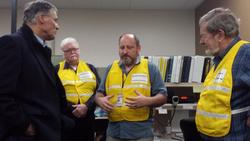
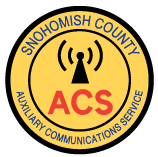
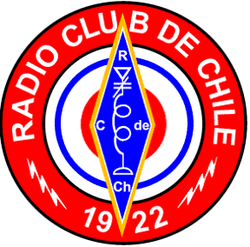
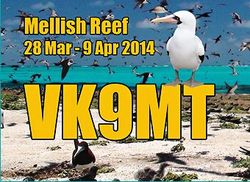
.jpg)
